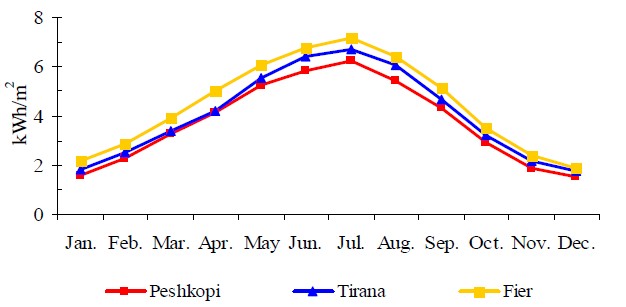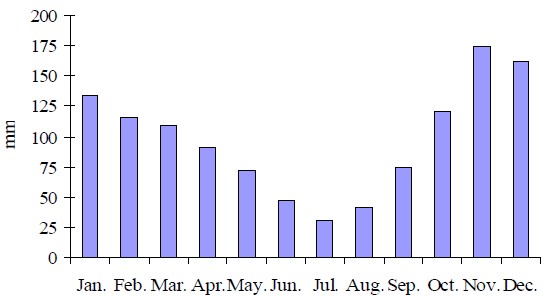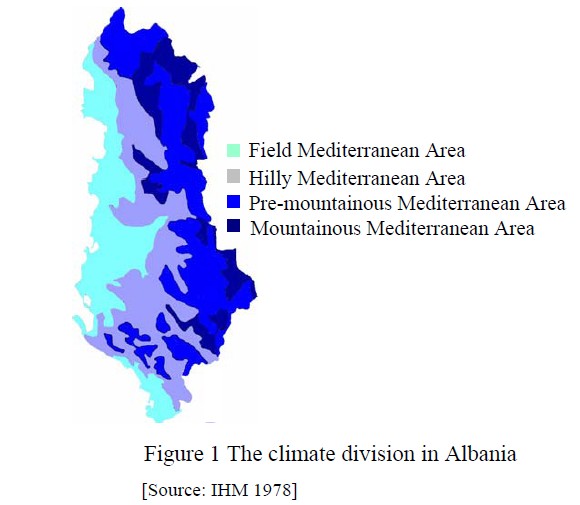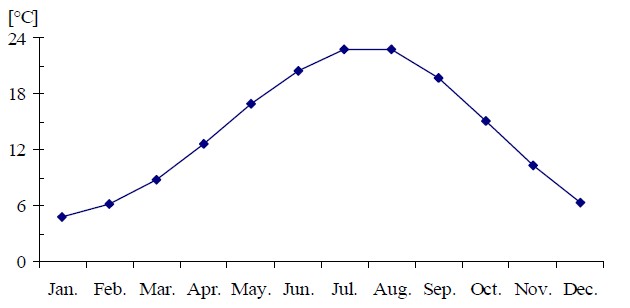Climate characteristics of Albania
Albania is one of the Mediterranean countries. The geographic position of Albania gives to this country a Mediterranean climate, which is characterized by a wet and soft winter and a hot and dry summer. The climate regime of Albania is influenced by the frequency of occasional atmospheric systems, which are mainly the depressions coming from North Atlantic and Mediterranean Sea including the anti-cyclones coming from Siberia and Azores, as well. One of the main other factors that influence the climate conditions of a certain region is the closeness to the sea (IHM 1978).
As far as the Albanian territory is concerned, it has been noticed that there is a considerable increase from the sea level and removal towards the inner part of the territory. The inner part of the country is basically mountainous. The influences of the before-mentioned factors have brought out a great number of indicators and climate parameters in different regions of Albania.
As mentioned, the territory of Albania is divided in four main climate areas. Whole its elements are basically stable. These areas are name as following: The Field Mediterranean Area, The Hilly Mediterranean Area, The Pre-mountainous Mediterranean Area and Mountainous Mediterranean Area.
Air Temperature
The distribution of the temperatures in Albania presents a considerable variability. The annual average temperature is 8-9 0C in the mountainous area up to 17 0C in the seaside south-west area. During the year, the curb of the temperatures in the whole country is quite regular with a maximum in the summer months and the minimum in the winter months, as presented in the Figure 2. The period of the average of these calculations is during the years 1961-2000 .
The Annex A shows some tables with average middle monthly temperatures in the main cities for a period of 40 years. Some graphics that indicate the annual progress of the air temperature for the last 10 years are presented, as well. It is very interesting to analyze the data given in Annex A. It results that the variability of the temperatures in July (the highest) and January (the lowest) is lower than the one in the stations within the country. Concretely, in Vlora this difference is approximately 15 0C, in Kukes approximately 21.5 0C. This fact confirms the influence of the seaside in the territories around it. This influence does not allow a decrease of the air temperature during winter and a high increase during summer.

Figure 3 Daily mean average solar radiation for the 3 meteorological stations in Albania
Solar radiation
Figure 3 presents the daily mean average solar radiation according to the months for 3 main meteorological stations in Albania. It shows, as well, the existence of huge differences between the different seasons and stations in the country. According to these data, Peshkopia station, located in North-East shows a difference from a minimum of 1,5 kWh/m2 in December to a maximum of 6.25 kWh/m2 in July. The same phenomenon happens in the other stations as well (EEC 2005).
The ratio between the month of the highest solar radiation and the one of the minimal solar radiation varies from the smallest values of 4 for the stations of Erseka and Saranda to the values of 5 kWh/m2 for Fier and Peshkopi. Annex A includes a detailed table with data for each station.

Figure 4 Average quantity of the monthly falls in the main cities of Albania during period of
1961 – 2000
Rain falls
The rainfalls in Albania have a Mediterranean regime. They are mainly active during winter months (65-75 % of the annual quantity) and less during the summer ones. Albania is characterized from a huge variation as far as the territorial distribution is concerned. The annual amount varies from 650 mm in the South-East to 2800 mm in the Alps of Albania. The average amount of falls for the whole territory is approximately 1400 mm annually. This is an indicator for a huge slack of falls, which can be used for energy. Below there is a graphic of the average amount of falls for the period of 40 years: 1961 – 2000. Compared to the temperatures, the falls’ regime in the last 10 years can be easily distinguished from previous one. The detail amount on the falls in the last 10 years is enclosed in Annex A.


